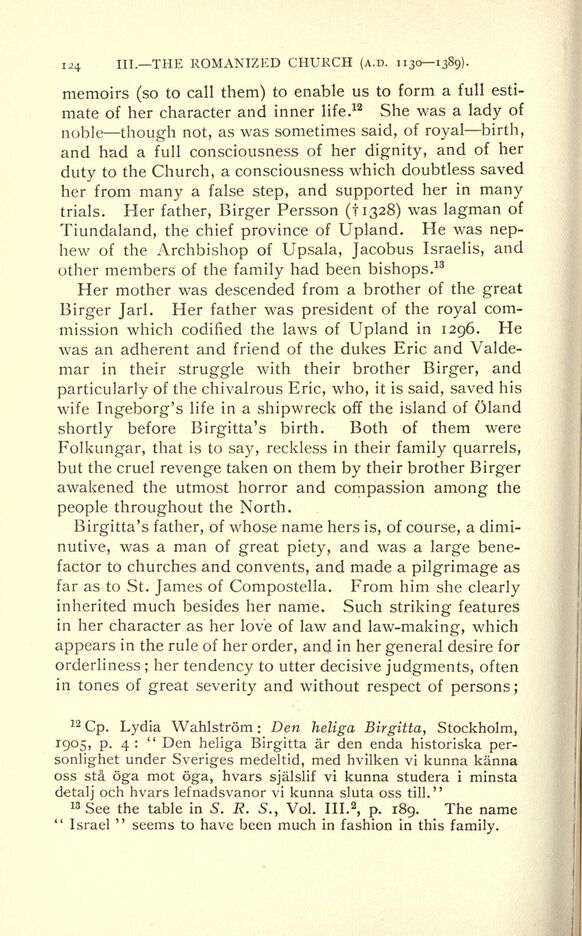
Full resolution (JPEG) - On this page / på denna sida - III. The Romanized Church under the Sverkers, Erics and Folkungar (1130—1389 A.D.)

<< prev. page << föreg. sida << >> nästa sida >> next page >>
Below is the raw OCR text
from the above scanned image.
Do you see an error? Proofread the page now!
Här nedan syns maskintolkade texten från faksimilbilden ovan.
Ser du något fel? Korrekturläs sidan nu!
This page has never been proofread. / Denna sida har aldrig korrekturlästs.
124 III. THE ROMANIZED CHURCH (A.D. 11301389).
memoirs (so to call them) to enable us to form a full esti
mate of her character and inner life.
12
She was a lady of
noble though not, as was sometimes said, of royal birth,
and had a full consciousness of her dignity, and of her
duty to the Church, a consciousness which doubtless saved
her from many a false step, and supported her in many
trials. Her father, Birger Persson (11328) was lagman of
Tiundaland, the chief province of Upland. He was nep
hew of the Archbishop of Upsala, Jacobus Israelis, and
other members of the family had been bishops.
13
Her mother was descended from a brother of the great
Birger Jarl. Her father was president of the royal com
mission which codified the laws of Upland in 1296. He
was an adherent and friend of the dukes Eric and Valde-
mar in their struggle with their brother Birger, and
particularly of the chivalrous Eric, who, it is said, saved his
wife Ingeborg s life in a shipwreck off the island of Oland
shortly before Birgitta s birth. Both of them were
Folkungar, that is to say, reckless in their family quarrels,
but the cruel revenge taken on them by their brother Birger
awakened the utmost horror and compassion among the
people throughout the North.
Birgitta s father, of whose name hers is, of course, a dimi
nutive, was a man of great piety, and was a large bene
factor to churches and convents, and made a pilgrimage as
far as to St. James of Compostella. From him she clearly
inherited much besides her name. Such striking features
in her character as her love of law and law-making, which
appears in the rule of her order, and in her general desire for
orderliness ;
her tendency to utter decisive judgments, often
in tones of great severity and without respect of persons ;
12
Cp. Lydia Wahlstrom : Den heliga Birgitta, Stockholm,
1905, p. 4 :
"
Den heliga Birgitta ar den enda historiska per-
sonlig-het under Sveriges medeltid, med hvilken vi kunna kanna
oss sta oga mot oga, hvars sjalslif vi kunna studera i minsta
detalj och hvars lefnadsvanor vi kunna sluta oss till."
13
See the table in S. R. S. y
Vol. III. 2
, p. 189. The name
"
Israel
"
seems to have been much in fashion in this family.
<< prev. page << föreg. sida << >> nästa sida >> next page >>